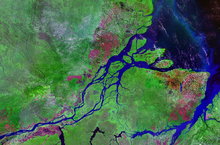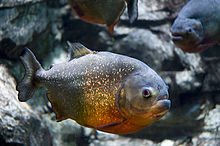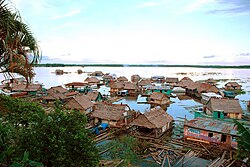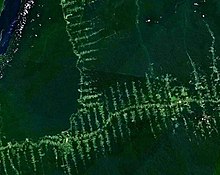Amazon basin


The Amazon basin is the part of South America drained by the Amazon River and its tributaries. The Amazon drainage basin covers an area of about 7,000,000 km2 (2,700,000 sq mi),[1] or about 35.5 percent of the South American continent. It is located in the countries of Bolivia, Brazil, Colombia, Ecuador, Guyana, Peru, Suriname, and Venezuela, as well as the territory of French Guiana.[2][3]
Most of the basin is covered by the Amazon rainforest, also known as Amazonia. With a 5.5 million km2 (2.1 million sq mi) area of dense tropical forest, it is the largest rainforest in the world.
Geography
The Amazon River begins in the Andes Mountains at the west of the basin with its main tributary the Marañón River and Apurimac River in Peru. The highest point in the watershed of the Amazon is the second biggest peak of Yerupajá at 6,635 metres (21,768 ft).
The Amazon River Basin occupies the entire central and eastern area of South America, lying to the east of the Andes mountain range and extending from the Guyana Plateau in the north to the Brazilian Plateau in the south.
With a length of about 6,400 km (4,000 mi) before it drains into the
The Amazon system transports the largest volume of water of any river system, accounting for about 20% of the total water carried to the oceans by rivers. Some of the Amazon rainforests are deforested because of an increase in cattle ranches and soybean fields. The Amazon basin formerly flowed west to the Pacific Ocean until the Andes formed, causing the basin to flow eastward towards the Atlantic Ocean.[6]
Politically the basin is divided into Peruvian Amazonia, Amazônia Legal of Brazil, the Amazon natural region of Colombia, Amazonas (Venezuelan state), and parts of Bolivia and Ecuador.
Plant life

Plant growth is quite dense and its variety of animal inhabitants is comparatively high due to the heavy rainfall and the dense and extensive
Wildlife

Mammals
More than 1,400 species of mammals are found in the Amazon, the majority of which are species of bats and rodents. Its larger mammals include the jaguar, ocelot, capybara, puma and South American tapir.
Birds
About 1,500 bird species inhabit the Amazon basin.[9] The biodiversity of the Amazon and the sheer number of diverse bird species is given by the number of different bird families that reside in these humid forests. An example of such would be the cotinga family, to which the Guianan cock-of-the-rock belong. Birds such as toucans, and hummingbirds are also found here. Macaws are famous for duck gathering by the hundreds along the clay cliffs of the Amazon River. In the western Amazon hundreds of macaws and other parrots descend to exposed river banks to consume clay on an almost daily basis,[10] the exception being rainy days.[11]
Reptiles
The green anaconda inhabits the shallow waters of the Amazon and the emerald tree boa and boa constrictor live in the Amazonian tree tops.
Many reptile species are illegally collected and exported for the international pet trade. Live animals are the fourth largest commodity in the smuggling industry after drugs, diamonds and weapons.[12]
Amphibians
More than 1,500 species of
Fish

About 2500
In addition to major differences in behavior and ecology, Amazonian fish vary extensively in form and size. The largest, the
The Amazon supports very large fisheries, including well-known species of large catfish (such as
Several
Some of the major fish groups of the Amazon basin include:[24]
- Order Gymnotiformes: Neotropical electric fishes
- Order Characiformes: characins, tetras and relatives
- Family Potamotrygonidae: river stingrays
- Family Arapaimidae: bonytongues
- Family Loricariidae: suckermouth catfishes
- Family Callichthyidae: armored catfishes
- Family Pimelodidae: pimelodid catfishes
- Family Trichomycteridae: pencil catfishes
- Family Auchenipteridae: driftwood catfishes
- Subfamily Cichlinae: pike cichlids, peacock cichlids and relatives
- Subfamily Geophaginae: Eartheaters and Neotropical dwarf cichlid
- Subfamily Poeciliinae: guppies and relatives
Insects
More than 90% of the animal species in the Amazon are insects,[36] of which about 40% are beetles (Coleoptera constituting almost 25% of all known types of animal life-forms.)[37][38][39]
Whereas all of Europe has some 321
Climate
The Amazon River basin has a low-water season (known popularly as summer), and a wet season (known popularly as winter) during which, the rivers flood the adjacent, low-lying forests. The climate of the basin is generally hot and humid. In some areas, however, the summer months (June–September) can bring cold snaps, fueled by Antarctic winds traveling along the adjacent mountain range. The average annual temperature is around 25-degree and 28 degree Celsius with little to no distinction between summer and winter season.
Human lifestyle

Amazonia is
Languages
The most widely spoken languages in the Amazon are Portuguese and Spanish. There are hundreds of native languages still spoken in the Amazon, most of which are critically endangered.
Indigenous peoples
Many tribal groups live in the Amazon Basin, often in relative isolation. It is estimated 400 or more tribal groups have lived in the Amazon Basin for hundreds of years with their own culture, language, and lifestyle. Today total population of Amazon basin is 1.5 million distributed. There are an estimated 100 uncontacted tribal groups. The largest organization fighting for the indigenous peoples in this area is COICA. It is a supra organization encompassing all indigenous rights organizations working in the Amazon basin area, and covers the people living in several countries.
River commerce
The river is the principal path of transportation for people and produce in the regions, with transport ranging from balsa rafts and dugout canoes to hand built wooden river craft and modern steel hulled craft.
Agriculture
Seasonal floods excavate and redistribute nutrient-rich silt onto beaches and islands, enabling dry-season riverside agriculture of rice, beans, and corn on the river's shoreline without the addition of fertilizer, with additional

Extensive deforestation, particularly in Brazil, is leading to the extinction of known and unknown species, reducing biological diversity and adversely impacting soil, water, and air quality. A final part of the deforestation process is the large-scale production of charcoal for industrial processes such as steel manufacturing. Soils within the region are generally shallow and cannot be used for more than a few seasons without the addition of imported fertilizers and chemicals.
Global ecological role / Function for climate change
This section needs expansion. You can help by adding to it. (June 2023) |
"Over past 20 years (2021), the Brazilian Amazon emitted 13% more CO2 than it absorbed".[40] [41]
"Amazon biodiversity also plays a critical role as part of global systems, influencing the global carbon cycle and thus climate change, as well as hemispheric hydrological systems, serving as an important anchor for South American climate and rainfall. It also produces 20% oxygen of the Earth."[42]
See also
- Amazon biome
- Amazon Cooperation Treaty Organization
- Amazon Conservation Association
- Amazon Conservation Team
- Deforestation of the Amazon rainforest
- Llanos de Moxos
- Llanos de Moxos (archaeology)
- Ucayali Peneplain
- Pre-Colombian agriculture in the Amazon Basin
References
- ^ "Amazon River". britannica.com. Encyclopaedia Britannica.
- ISBN 1-58834-135-6
- ^ "Amazon". World Wildlife Fund. 24 March 2023.
- ^ Roach, John (18 June 2007). "Amazon Longer Than Nile River, Scientists Say". National Geographic. Archived from the original on 22 August 2007.
- ^ Raymond E. Crist; Alarich R. Schultz; James J. Parsons (16 March 2018). "Amazon River". Encyclopædia Britannica. Retrieved 21 August 2018.
- ^ "Amazon river flowed into the Pacific millions of years ago". Mongabay. 24 October 2006. Archived from the original on 3 January 2013. Retrieved 8 June 2014.
- ^ Amazon, Plants. "Amazon plants and trees".
- ^ "The Coolest Plants in the Amazon Rainforest". Rainforest Cruises.
- ^ Butler, Rhett (31 July 2012). "Diversities of Image". Mongabay.com. Retrieved 20 December 2014.
- ^ Munn, C. A. 1994. Macaws: winged rainbows. National Geographic, 185, 118–140.
- S2CID 83509448.
- ^ "Amazon Reptiles". Mongabay.com.
- ^ S2CID 83788515
- ISBN 978-0-520-26868-5.
- PMID 27312713.
- S2CID 86617207.
- ^ Mendonça, F. P., W. E. Magnusson, J. Zuanon and C. M. Taylor. (2005) Relationships between habitat characteristics and fish assemblages in small streams of Central Amazonia. Copeia 2005(4): 751–764
- ^ Duncan, W.P.; and Fernandes, M.N. (2010). Physicochemical characterization of the white, black, and clearwater rivers of the Amazon Basin and its implications on the distribution of freshwater stingrays (Chondrichthyes, Potamotrygonidae). PanamJAS 5(3): 454–464.
- ^ Froese, Rainer; Pauly, Daniel (eds.) (2017). "Arapaima gigas" in FishBase. September 2017 version.
- ^ Froese, Rainer; Pauly, Daniel (eds.) (2017). "Brachyplatystoma filamentosum" in FishBase. September 2017 version.
- ^ Froese, Rainer; Pauly, Daniel (eds.) (2017). "Carcharhinus leucas" in FishBase. September 2017 version.
- ^ Froese, Rainer; Pauly, Daniel (eds.) (2017). "Pristis pristis" in FishBase. September 2017 version.
- ^ Roberts, T.R. (2013). "Leptophilypnion, a new genus with two new species of tiny central Amazonian gobioid fishes (Teleostei, Eleotridae)". Aqua, International Journal of Ichthyology. 19 (2): 85–98.
- ^ ISBN 978-0691170749.
- ^ ISBN 978-1402000768.
- ISBN 978-1421418636.
- ^ Lujan, Nathan. K.; Chamon, Carine. C. (2008). "Two new species of Loricariidae (Teleostei: Silurifomes) from main channels of the upper and middle Amazon Basin, with discussion of deep water specialization in loricariids". Ichthyological Exploration of Freshwaters. 19: 271–282.
- .
- .
- ^ Howard, Brian Clark (27 September 2013). "Fish That Lay Eggs Out of the Water". National Geographic. Water Currents. Archived from the original on 28 May 2015.
- ^ SeriouslyFish. "Lepidosiren paradoxa". Retrieved 30 April 2017.
- ^ Vermeulen, F. "The genus Rivulus". itrainsfishes.net. Retrieved 6 May 2017.[permanent dead link]
- PMID 26299792.
- ^ Planet Catfish. "Cat-eLog: Heptapteridae: Phreatobius: Phreatobius sp. (1)". Planet Catfish. Retrieved 30 April 2017.
- .
- ^ "Amazon Insects". Mongabay.com.
- ^ Powell (2009)
- ISBN 978-0-521-49952-1.
- S2CID 19392955.
- ^ "Rapid deforestation outweighs carbon capture by remaining trees". The Economist. 21 May 2022. Retrieved 10 June 2023.
- ^ Kaiser, Anna Jean (27 August 2019). "Explainer: Role of the Amazon in global climate change". phys.org. Retrieved 12 February 2023.
- ^ "Why the Amazon's Biodiversity is Critical for the Globe: An Interview with Thomas Lovejoy". World Bank. Retrieved 12 February 2023.
Further reading
- Acker, Antoine. "Amazon" (2015). Center for InterAmerican Studies, University Bielefeld.
- Dematteis, Lou; Szymczak, Kayana (June 2008). Crude Reflections/Cruda Realidad: Oil, Ruin and Resistance in the Amazon Rainforest. City Lights Publishers. ISBN 978-0-87286-472-6.
External links
- Herndon and Gibbon Lieutenants United States Navy—An except from the book The First North American Explorers of the Amazon Valley, by historian Normand E. Klare. Actual reports from the explorers are compared with present Amazon basin conditions.
- "Scientists find Evidence Discrediting Theory Amazon Was Virtually Unlivable" by The Washington Post
- "The Course of the River of the Amazons, Based on the Account of Christopher d'Acugna" from 1680 (map
